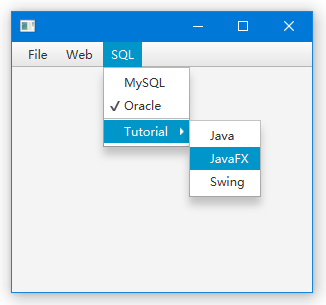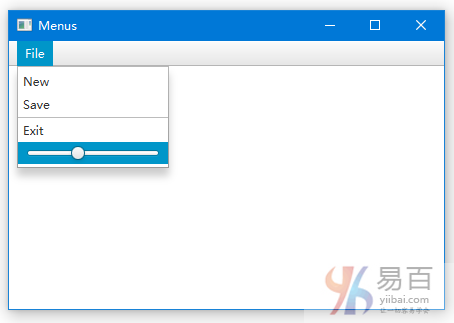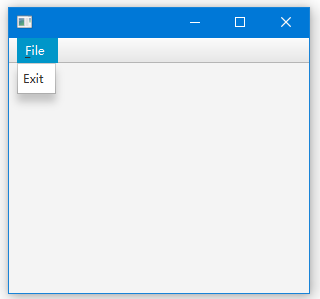JavaFX菜單(Menu)
菜單是桌面應用程序選擇選項的標準方法。
菜單和菜單項可以與選擇選項快捷鍵組合,稱爲鍵盤快捷鍵。
創建菜單和菜單項
必須創建一個菜單欄javafx.scene.control.MenuBar對象來保存javafx.scene.control.Menu對象。
菜單對象可以包含Menu和javafx.scene.control.MenuItem對象。菜單可以包含其他菜單作爲子菜單。MenuItems是Menu對象內的子選項。
以下代碼顯示如何創建菜單欄並添加菜單和菜單項。
Menu類是MenuItem的子類,它有一個getItems().add()方法,它能夠添加諸如其他Menu和MenuItem實例的子元素。
import javafx.application.Application;
import javafx.application.Platform;
import javafx.scene.Scene;
import javafx.scene.control.CheckMenuItem;
import javafx.scene.control.Menu;
import javafx.scene.control.MenuBar;
import javafx.scene.control.MenuItem;
import javafx.scene.control.RadioMenuItem;
import javafx.scene.control.SeparatorMenuItem;
import javafx.scene.control.ToggleGroup;
import javafx.scene.layout.BorderPane;
import javafx.scene.paint.Color;
import javafx.stage.Stage;
public class Main extends Application {
@Override
public void start(Stage primaryStage) {
BorderPane root = new BorderPane();
Scene scene = new Scene(root, 300, 250, Color.WHITE);
MenuBar menuBar = new MenuBar();
menuBar.prefWidthProperty().bind(primaryStage.widthProperty());
root.setTop(menuBar);
// File menu - new, save, exit
Menu fileMenu = new Menu("File");
MenuItem newMenuItem = new MenuItem("New");
MenuItem saveMenuItem = new MenuItem("Save");
MenuItem exitMenuItem = new MenuItem("Exit");
exitMenuItem.setOnAction(actionEvent -> Platform.exit());
fileMenu.getItems().addAll(newMenuItem, saveMenuItem,
new SeparatorMenuItem(), exitMenuItem);
Menu webMenu = new Menu("Web");
CheckMenuItem htmlMenuItem = new CheckMenuItem("HTML");
htmlMenuItem.setSelected(true);
webMenu.getItems().add(htmlMenuItem);
CheckMenuItem cssMenuItem = new CheckMenuItem("CSS");
cssMenuItem.setSelected(true);
webMenu.getItems().add(cssMenuItem);
Menu sqlMenu = new Menu("SQL");
ToggleGroup tGroup = new ToggleGroup();
RadioMenuItem mysqlItem = new RadioMenuItem("MySQL");
mysqlItem.setToggleGroup(tGroup);
RadioMenuItem oracleItem = new RadioMenuItem("Oracle");
oracleItem.setToggleGroup(tGroup);
oracleItem.setSelected(true);
sqlMenu.getItems().addAll(mysqlItem, oracleItem,
new SeparatorMenuItem());
Menu tutorialManeu = new Menu("Tutorial");
tutorialManeu.getItems().addAll(
new CheckMenuItem("Java"),
new CheckMenuItem("JavaFX"),
new CheckMenuItem("Swing"));
sqlMenu.getItems().add(tutorialManeu);
menuBar.getMenus().addAll(fileMenu, webMenu, sqlMenu);
primaryStage.setScene(scene);
primaryStage.show();
}
public static void main(String[] args) {
launch(args);
}
}上面的代碼生成以下結果。

指定菜單項
要將選中的選項或單選按鈕添加到菜單,可以使用MenuItem類作爲菜單的子類。以下列表顯示了可用作菜單選項的MenuItem子類。
- javafx.scene.control.CheckMenuItem
- javafx.scene.control.RadioMenuItem
- javafx.scene.control.CustomMenuItem
- javafx.scene.control.SeparatorMenuItem
- javafx.scene.control.Menu
CheckMenuItem菜單項類似於複選框控件,允許用戶選擇項。RadioMenuItem菜單項類似於RadioButton控件,允許用戶從項目組中僅選擇一個項目。
要創建自定義菜單項,可以使用CustomMenuItem類。SeparatorMenuItem是CustomMenuItem類型的派生類,並顯示用於分隔菜單項的視線。使用CustomMenuItem將Slider添加到MenuItem上。可參考以下代碼實現 -
import javafx.application.Application;
import javafx.scene.Group;
import javafx.scene.Scene;
import javafx.scene.control.CustomMenuItem;
import javafx.scene.control.Menu;
import javafx.scene.control.MenuBar;
import javafx.scene.control.MenuItem;
import javafx.scene.control.SeparatorMenuItem;
import javafx.scene.control.Slider;
import javafx.scene.paint.Color;
import javafx.stage.Stage;
public class Main extends Application {
public static void main(String[] args) {
Application.launch(args);
}
@Override
public void start(Stage primaryStage) {
primaryStage.setTitle("Menus");
Group root = new Group();
Scene scene = new Scene(root, 300, 250, Color.WHITE);
MenuBar menuBar = new MenuBar();
Menu menu = new Menu("File");
menu.getItems().add(new MenuItem("New"));
menu.getItems().add(new MenuItem("Save"));
menu.getItems().add(new SeparatorMenuItem());
menu.getItems().add(new MenuItem("Exit"));
CustomMenuItem customMenuItem = new CustomMenuItem(new Slider());
customMenuItem.setHideOnClick(false);
menu.getItems().add(customMenuItem);
menuBar.getMenus().add(menu);
menuBar.prefWidthProperty().bind(primaryStage.widthProperty());
root.getChildren().add(menuBar);
primaryStage.setScene(scene);
primaryStage.show();
}
}上面的代碼生成以下結果。

菜單事件處理程序
要向菜單項添加事件處理程序,可以使用setOnAction()方法,它接收一個類型爲EventHandler <ActionEvent>的功能接口,它是在選擇菜單項時調用的處理程序代碼。
import javafx.application.Application;
import javafx.application.Platform;
import javafx.scene.Scene;
import javafx.scene.control.Menu;
import javafx.scene.control.MenuBar;
import javafx.scene.control.MenuItem;
import javafx.scene.layout.BorderPane;
import javafx.scene.paint.Color;
import javafx.stage.Stage;
public class Main extends Application {
@Override
public void start(Stage primaryStage) {
BorderPane root = new BorderPane();
Scene scene = new Scene(root, 300, 250, Color.WHITE);
MenuBar menuBar = new MenuBar();
menuBar.prefWidthProperty().bind(primaryStage.widthProperty());
root.setTop(menuBar);
Menu fileMenu = new Menu("File");
MenuItem exitMenuItem = new MenuItem("Exit");
fileMenu.getItems().add(exitMenuItem);
exitMenuItem.setOnAction(actionEvent -> Platform.exit());
menuBar.getMenus().addAll(fileMenu);
primaryStage.setScene(scene);
primaryStage.show();
}
public static void main(String[] args) {
launch(args);
}
}上面的代碼生成以下結果。

關鍵助記符
標準菜單通常具有鍵盤助記符(類似於快捷鍵),以在不使用鼠標的情況下選擇菜單項。
用戶可以按Alt鍵和帶下劃線_的字母來激活菜單,然後使用箭頭鍵導航。要向菜單添加鍵助記符,使用String值調用構造函數,並在菜單或菜單項的文本中在所選字母前面放置一個下劃線字符。
然後將true傳遞給setMnemonicParsing(true)方法。
以下代碼創建一個使用字母「F」作爲助記符的文件菜單。
Menu fileMenu = new Menu("_File");
fileMenu.setMnemonicParsing(true);完整的源代碼實現,如下所示 -
import javafx.application.Application;
import javafx.application.Platform;
import javafx.scene.Scene;
import javafx.scene.control.Menu;
import javafx.scene.control.MenuBar;
import javafx.scene.control.MenuItem;
import javafx.scene.layout.BorderPane;
import javafx.scene.paint.Color;
import javafx.stage.Stage;
public class Main extends Application {
@Override
public void start(Stage primaryStage) {
BorderPane root = new BorderPane();
Scene scene = new Scene(root, 300, 250, Color.WHITE);
MenuBar menuBar = new MenuBar();
menuBar.prefWidthProperty().bind(primaryStage.widthProperty());
root.setTop(menuBar);
Menu fileMenu = new Menu("_File");
fileMenu.setMnemonicParsing(true);
MenuItem exitMenuItem = new MenuItem("Exit");
fileMenu.getItems().add(exitMenuItem);
exitMenuItem.setOnAction(actionEvent -> Platform.exit());
menuBar.getMenus().addAll(fileMenu);
primaryStage.setScene(scene);
primaryStage.show();
}
public static void main(String[] args) {
launch(args);
}
}上面的代碼生成以下結果(同時按住Ctrl + ALT + F)。

鍵組合
鍵組合是用於選擇菜單選項的鍵擊的組合。鍵組合稱爲鍵盤快捷鍵。
例如,在Windows平臺上,Ctrl + S的組合鍵可以保存文件。 在Mac OS平臺上,組合鍵爲Command + S.
Ctrl,Command,Alt,Shift和Meta等鍵稱爲修飾鍵。
通常,修飾符與單個字母組合使用。要創建一個組合鍵,使用KeyCodeCombination對象,並傳入擊鍵和修飾符。
以下代碼創建(Ctrl或Meta)+ S的鍵代碼組合。
MenuItem saveItem = new MenuItem("_Save");
saveItem.setMnemonicParsing(true);
saveItem.setAccelerator(new KeyCodeCombination(KeyCode.S, KeyCombination.SHORTCUT_DOWN));代碼使用KeyCombination.SHORTCUT_DOWN值作爲鍵修飾符,而不是CONTROL_DOWN或META_DOWN。SHORTCUT_DOWN值將使應用程序能夠跨平臺使用。
CONTROL_DOWN和META_DOWN值分別依賴於Windows和MacOS平臺,但是SHORTCUT_DOWN在所有平臺上都有效。
上下文菜單
上下文菜單是當用戶右鍵單擊鼠標按鈕時顯示的彈出菜單。
要創建上下文菜單,請使用ContextMenu類。ContextMenu菜單有一個getItems().add()方法來添加菜單項。
以下代碼顯示了使用菜單項(exitItem)實例化的上下文菜單:
ContextMenu contextFileMenu = new ContextMenu(exitItem);要響應鼠標右鍵單擊,請添加一個事件處理程序,以監聽右鍵單擊事件並調用上下文菜單的show()方法。
以下代碼設置了一個事件處理程序,以分別基於右鍵或左鍵單擊來顯示和隱藏上下文菜單。
hide()方法由主鼠標單擊(左鍵單擊)調用以刪除上下文菜單。
primaryStage.addEventHandler(MouseEvent.MOUSE_CLICKED, (MouseEvent me) -> {
if (me.getButton() == MouseButton.SECONDARY || me.isControlDown()) {
contextFileMenu.show(root, me.getScreenX(), me.getScreenY());
} else {
contextFileMenu.hide();
}
});